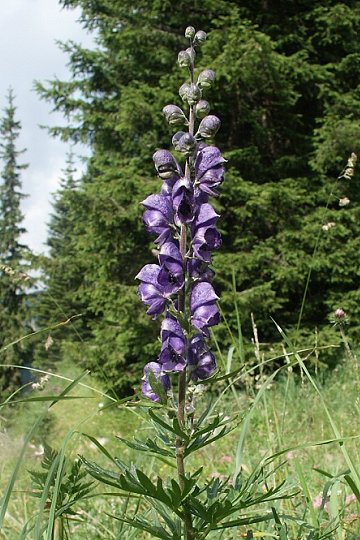
|
|
Aconite - Monkshood - Wolfsbane
(Aconitum napellus).
|
Aconite - Monkshood - Wolfsbane - Aconitum napellus
Aconitum napellus (monk's-hood, aconite, wolfsbane) is a species of highly toxic flowering plant in the genus Aconitum of the family
Ranunculaceae, that is most closely related to delphiniums. The genus grows in
cool, moist mountain regions with the highest concentration of species found in high elevations regions of
Asia. About 250 species are known with five native to North America.
Plants native to Asia and North America formerly listed as A. napellus are now regarded as separate
species. This species is native to Europe.
Aconitum napellus is a long lived tuber forming
herbaceous perennial native and endemic to western and central Europe. It is
a plant growing to 1 m (3 ft 3 in) tall, with hairless stems and leaves. The leaves are
rounded, 5–10 cm (2.0–3.9 in) diameter, palmately divided into five to seven deeply lobed
segments. The flowers appearing from midsummer until fall are dark purple to
bluish-purple, narrow oblong helmet-shaped, 1–2 cm (0.39–0.79 in) tall. The covering hood of the flower is a domed modified sepal that shrouds the inner parts of the
flower. In nature aconite is pollinated by bumblebees so the volume of the hood is sufficiently large to allow access to the
bee. The below-ground tubers are fleshy with the species epitaph translating as “little
turnips.”
The plant is extremely poisonous in both ingestion and skin
contact. All parts of the plant are poisonous. The name “wolfsbane” comes from the old European practice of poisoning wolves with meat scraps laced with Aconite
roots. The name aconitum comes from the Greek ἀêüíéôïí, which may derive from the Greek akon for dart or
javelin, the tips of which were poisoned with the substance, or from akonae, because of the rocky ground on which the plant was thought to grow
Like other species in the genus, A. napellus contains several poisonous
compounds, including enough cardiac poison that it was used on spears and arrows for hunting and battle in ancient
times. The poisonous principle has been used to coat poisonous arrows, and in
Alaska, harpoons for whale hunting. A. napellus has a long history of use as a
poison, with cases going back thousands of years. During the ancient Roman period of European
history, the plant was often used to eliminate criminals and enemies, and by the end of the period it was banned and anyone growing A. napellus could have been legally sentenced to
death. Aconites have been used more recently in murder plots. It has been the favorite poison of suspense writers for the past several centuries and its use continues in the plethora of modern day
who-done-its on TV serials. It contain the chemical alkaloids aconitine,
mesaconitine, hypaconitine and jesaconitine, which are highly toxic.
Aconite, although it is a very powerful poison, is considered one of the top medicinal
plants.
Aconite has been used since ancient times, especially as an antidote to
poisoning. Since the entire plant is itself very toxic, however, any use should be under the guidance of a skilled
practitioner. All parts of the plant are used medicinally. The root is the most important and this is harvested as soon as the plant dies down in the autumn and is dried before
use. The other parts of the plant are less important and are used fresh, being harvested when the plant is coming into
flower. The root is analgesic, anodyne, antirheumatic, diaphoretic, diuretic, irritant and
sedative. Due to its poisonous nature, it is not normally used internally though it has been used in the treatment of
fevers. Externally, it is applied to unbroken skin in the treatment of
rheumatism, painful bruises, neuralgia etc. All parts of the plant, except the
root, are harvested when the plant is in flower and used to make a homeopathic
medicine. This is analgesic and sedative and is used especially in the treatment of
fevers, inflammation, bronchitis, neuralgia etc.
Aconitum napellus is grown in gardens for its attractive spike-like inflorescences and showy blue
flowers. It is a cut flower crop used for fresh cutting material and sometimes used as dried
material. The species has a low natural propagation rate under cultivation and is propagated by seed or by removing offsets that are generated each year from the
rootstocks. The use of micropropagation protocols has been studied.[8] This species has been crossed with other Aconitums to produce attractive hybrids for garden
use, including Aconitum x cammarum.
But having monkshood in your garden amongst all the other theoretically poisonous plants — everything from azaleas to potatoes — is not by itself
dangerous. Brushing against the plant or even accidental ingestion of a small amount of leaf tissue is not going to be
fatal. As with any poison, the dose administered is what causes the problem. Not planting any potentially poisonous plant with easy to confuse tubers in the vegetable garden is a
common-sense precaution. And, obviously, don’t assume anything green is good to add to a
salad.
Source:
https://en.wikipedia.org/wiki/Aconitum_napellus
https://pfaf.org/user/Plant.aspx?LatinName=Aconitum+napellus
https://www.uaex.edu/yard-garden/resource-library/plant-week/
aconitum-napellus-monkshood-wolfsbane-05-13-2016.aspx
